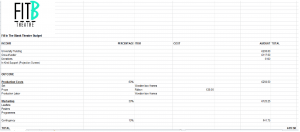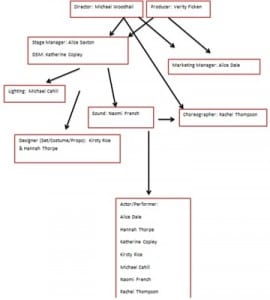In a theatre company, “the producer’s role can appear confusing and indefinable. The briefest of definitions would be that the producer is responsible for delivering a good show, on time and in budget” (Seabright, 2010, p.5) Seabright’s definition of a producer’s role in a theatre company is similar to that of mine, as producer of Fill In The Blank Theatre.
Freakley and Sutton note that “working creatively in a group brings different challenges. It can be a very rewarding experience since a group of imaginative people working together can very often achieve far more than they could as individuals”. (Freakley and Sutton, 1996, p.120) This is certainly the case in our theatre company as it consists of 10 artists. In order to keep good working relationships, Freakley and Sutton note that they are maintained “by knowing when to insist, when to let go and when to compromise” (Freakley and Sutton, 1996, p.121). This will certainly need to be the case within our theatre company as we are devising our piece.
Within my role, I am responsible for ensuring that the work we create as a company is of a professional standard, finished within plenty of time before the opening night and ensuring all of this is done within budget. It is also part of my job role to communicate with all members of the company, in particular the production team, ensuring that everyone is on task and is on board with the same vision. As part of my role, I will keep minutes of all meetings/rehearsals to ensure that we don’t forget topics/ideas we have discussed and it also means I can make sure we stay on track with the schedule.
We established early on that we wanted to be a collaborative devising company. Although we’d have defined roles in regards to the production, we’d all be able to input creatively into the devising process assisting our Director (Michael). Below is our company structure and how the roles co-inside and communicate with each other;
(Ficken, 2015)
As you can see from the above diagram, several of the company roles are connected. Firstly the producer and director are linked with the stage manager as ongoing discussions need to be had during the process in order to decide what the staging will look like and if it will fit in with the Director’s vision. The stage manager is then responsible for contacting the set, lighting and sound designers in order to set them upon the task of sourcing and creating the set for the performance. As producer I will also be in regular contact with the marketing manager to discuss plans of how and when we will market the show for example discussing the copy of the show and deciding on an image.
As aforementioned briefly, one of my main responsibilities as producer is to make sure that the performance is all kept under budget. Originally we decided that set and costume would have the smallest amount of budget as this fitted with the designer’s vision, however as time passed and ideas progressed it became evident that set would cost considerably more than first budgeted. Luckily as a theatre company, along with our budget given to us by the university, we fund-raised over £100 to add to our budget. Below is a draft of our budget. It is likely to change due to unforeseen costs, such as the labor costs of set.

(Ficken, 2015)
In order to ensure that the budget is kept up to date, I will be in regular contact with our Stage Manager (Alice S) and Assistant Stage Manager (Katherine).
Verity – Producer, Fill In The Blank Theatre.
Works Cited:
Ficken, V. (2015) Company Structure.
Ficken, V. (2015) Company Budget.
Freakley, V., Sutton, R. (1996) Essential Guide to Business in the Performing Arts. London: Hodder and Stoughton Educational.
Seabright, J. (2010) So You Want To Be a Theatre Producer? London: Nick Hern Books.
